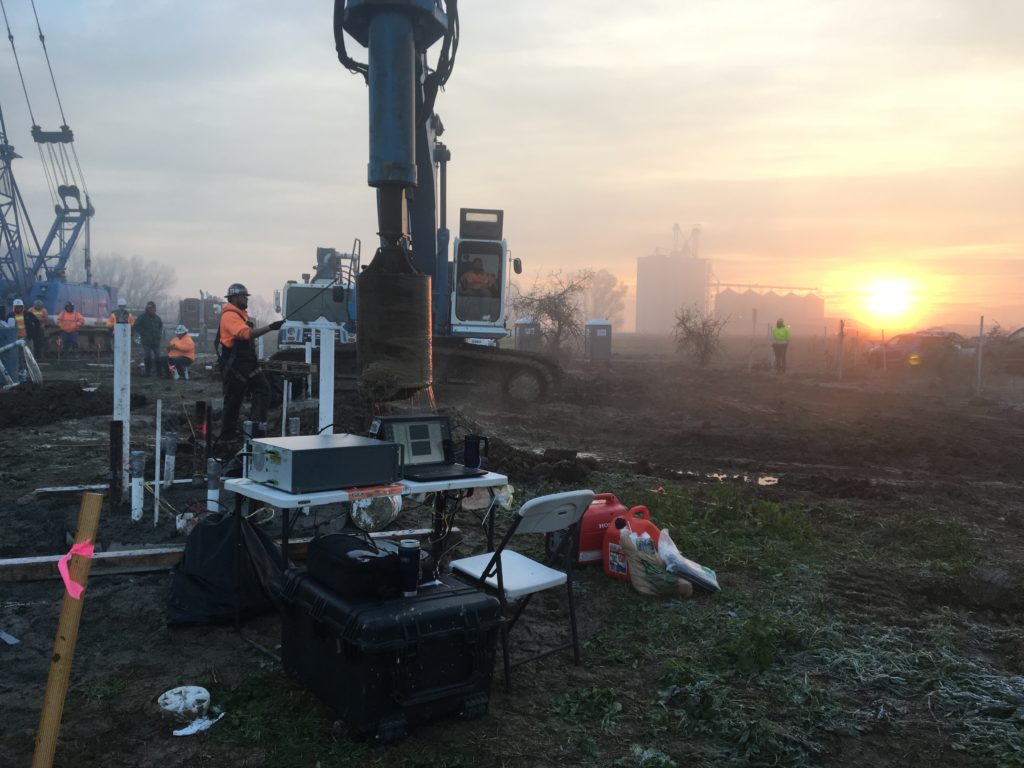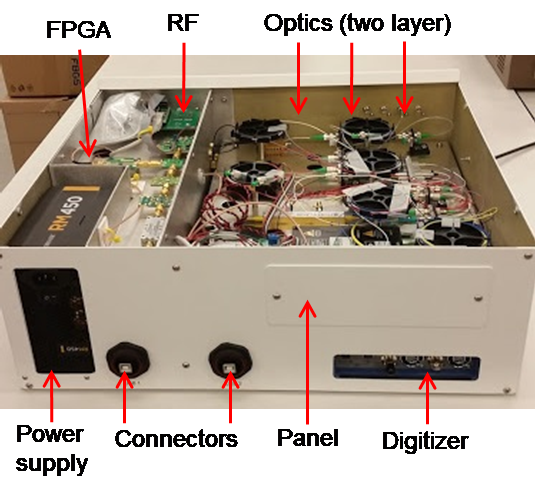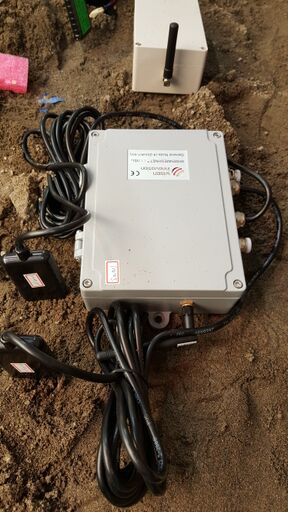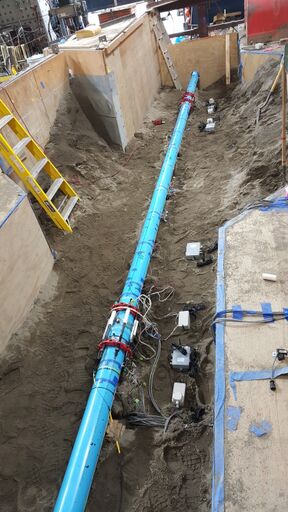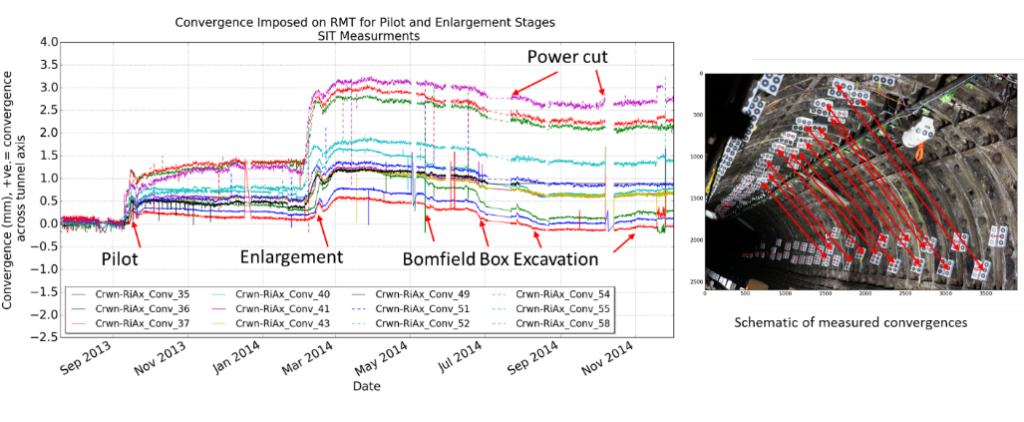The sensor technologies and methodologies are developed to transform the future of infrastructure and geomechanics through smart information. The data gathered permit an assessment of the behavior of the infrastructure in its environment and allow performance analyses. The group develops, tests and delivers new robust, resilient and adaptable technologies, such as distributed fiber optic sensors (DFOS), wireless sensor network (WSN), energy harvesting and computer vision.
Publication:
- Soga, K. and J. Schooling, “Infrastructure Sensing,” Interface Focus, Royal Society Publishing, June 2016, Vol. 6, No. 4, 17 pp.
- Soga, K., Ewais, A., Fern, J. and Park, J., 2019. Advances in Geotechnical Sensors and Monitoring. In Geotechnical Fundamentals for Addressing New World Challenges (pp. 29-65). Springer, Cham.
- Rodenas-Herráiz, D., K. Soga, P. Fidler and N. de Battista, Wireless Sensor Networks for Civil Infrastructure Monitoring – A Best Practice Guide, ICE Publishing, 2016, 208 pp.
- Kechavarzi, C., K. Soga, N. de Battista, L. Pelecanos, M. Elshafie and R.J. Mair, Distributed Optical Fibre Sensing for Monitoring Geotechnical Infrastructure – A Practical Guide, ICE Publishing, 2016, 192 pp.
Distributed Fiber Optic Sensors
The use of distributed fiber optic sensors (DFOS) for the monitoring of civil structures and infrastructure opens exciting new possibilities unmatched in conventional sensor systems.
Several technologies within the DFOS umbrella have developed to varying maturities in the last decade. These technologies include distributed strain sensing (DSS), distributed temperature sensing (DTS) and distributed acoustic sensing (DAS).
Distributed Strain Sensing – DSS
Engineering design limits are often based on strain and/or stress developing in the structure. For structures interacting with soil, the ground loads are distributed spatially (not point loads); therefore, the state of the structure cannot be fully understood unless the complete in situ strain condition is known. This is where DSS technology shines. A single optical fiber with a length of up to 10 km of continuous sensing make it possible to obtain a body of invaluable information on the distribution in civil infrastructure assets. Our group deploys DSS technology in laboratory and field applications to monitor natural in-situ, field load test and laboratory test conditions. We are also developing a dynamic Brillouin based DSS system that has been used for detecting dynamic strains in pavement.
Distributed Temperature Sensing – DTS
Infrastructure such as levees, dams, pipelines, natural gas wells and water distribution systems rely on their ability to avoid or at least control leakage. DTS technology provides that ability to monitor subtle temperature changes due to fluid flow using an optical fiber. Up to 50 km of linear asset can be monitored for distributed temperature. This gives engineers real-time capability to monitor subsurface flow within geotechnical infrastructure. Our group is working on deploying DTS technology in geotechnical infrastructure so better data analysis methods can be developed, and more information can be known about the condition of or infrastructure.
Distributed Acoustic Sensing – DAS
Many events that are of interest to civil engineers have acoustic signatures. Earthquakes, landslides, vibration, excavation and tunneling are just a few examples. DAS technology can measure the specific waveform of an acoustic signature along an optical fiber 10s of km long. This technology is revolutionary in infrastructure monitoring, asset management and even security. The problem is how we make use of exorbitant amounts of data. Our group is working on deploying DAS in infrastructure such as levee, pipelines and wellbores. We plan to develop methods for systematic signal processing and data analysis that will identify acoustic signatures of interest. Our group also plans to unite DSS and DAS technology so that static and dynamic strains can be monitored on demand and in synchrony.
Applications: pile foundations, tunnels, pipelines, pavements, levees and dams
At present, the high cost of analyzers is the major obstacle barring the widespread application of DFOS. However, recent developments in digital electronics and photonic integrated circuit provide an opportunity to transform the conventional analog-based system to digital based system. The group develop next generation of DFOS analyzers. Our new system has the following unique characteristics (i) low cost using an advanced digital architecture replacing the conventional microwave synthesizer, (ii) a special pulse and modulation to reduce measurement time for real-time dynamic sensing, and (iii) use of small gain stimulated Brillouin scattering with fast data management. This invention allows strain data to be captured at a high sampling rate. The current prototype system achieves 2cm read-out interval, 2m spatial resolution and about 20µε accuracy with 23Hz continuous monitoring.
Selected Recent Publications
- Kechavarzi, C., Soga, K., de Battista, N, Pelecanos, L., Elshafie, M. and Mair, R.J. (2016) Distributed Optical Fibre Sensing for Monitoring Geotechnical Infrastructure – A Practical Guide, ICE Publishing, 192pp.
- Gue, C.Y., M.J. Wilcock, M.M. Alhaddad, M.Z.E.B. Elshafie, K. Soga and R.J. Mair, “Tunnelling Close Beneath an Existing Tunnel in Clay–Perpendicular Undercrossing,” Géotechnique, September 2017, Vol. 67, No. 9, pp. 795-807, doi: 10.1680/jgeot.SiP17.P.117.
- Pelecanos, L., K. Soga, M.P.M. Chunge, Y. Ouyang, V. Kwan, C. Kechavarzi and D. Nicholson, “Distributed Fibre-Optic Monitoring of an Osterberg-Cell Pile Test in London,” Géotechnique Letters, June 2017, Vol. 7, No. 2, pp. 152-160, doi: 10.1680/jgele.16.00081.
- Pelecanos, L., K. Soga, M. Elshafie, N. de Battista, C. Kechavarzi, C.Y. Gue, Y. Ouyang and H. Seo, “Distributed Fibre Optic Sensing of Axially Loaded Bored Piles,” Journal of Geotechnical and Geoenvironmental Engineering, American Society of Civil Engineers, March 2018, Vol. 144, No. 3, pp. 16, doi: 10.1061/(ASCE) GT.1943-5606.0001843.
- Soga, K. and L. Luo, “Distributed Fiber Optics Sensors for Civil Engineering Infrastructure Sensing,” Journal of Structural Integrity and Maintenance, February 2018, Vol. 3, No. 1, pp. 1-21, doi: 10.1080/24705314.2018.1426138.
- Li, Z., Soga, K. and Kechavarzi, C. Distributed fibre optic sensing of a deep excavation adjacent to pre-existing tunnels, Geotechnique Letters, 8(3):171-177.
- Acikgoz, S., M.J. DeJong, C. Kechavarzi and K. Soga, “Dynamic Response of a Damaged Masonry Rail Viaduct: Measurement and Interpretation,” Engineering Structures, August 2018, Vol. 168, No. 1, pp. 544-558, doi: 10.1016/j.engstruct.2018.04.054.
- Rui, Y., C. Kechavarzi, F. O’Leary, C. Barker, D. Nicholson and K. Soga, “Integrity Testing of Pile Cover Using Distributed Fibre Optic Sensing,” Sensors 2017, December 2017, Vol. 17, No. 12, pp. 2949, doi: 10.3390/s17122949.
- Acikgoz, M.S., L. Pelecanos, G. Giardina, J. Aitken and K. Soga, “Distributed Sensing of a Masonry Vault Due to Nearby Piling,” Structural Control and Health Monitoring, March 2017, Vol. 24, No. 3, 19 pp., doi: 10.1002/stc.1872.
- Schwamb, T., M. Elshafie, K. Soga and R.J. Mair, “Considerations for Monitoring of Deep Circular Excavations,” Proceedings of ICE – Geotechnical Engineering, December 2016, Vol. 169, No. 6, pp. 477-493, doi: 10.1680/jgeen.15.00063.
- Luo, L., Sekiya, H., and Soga, K. (2019). “Dynamic Distributed Fiber Optic Strain Sensing on Movement Detection.” IEEE Sensors Journal, 19(14), 5639–5644.
- Li, B., L. Luo, Y. Yu, K. Soga and J. Yan, “Dynamic Strain Measurement Using Small Gain Stimulated Brillouin Scattering in STFT-BOTDR,” IEEE Sensors Journal, May 2017, Vol. 17, No. 9, pp. 2718-2724, doi: 10.1109/JSEN.2017.2657119
- Luo, L., Parmigiani, F., Y. Yu, B. Li, K. Soga and J. Yan, “Frequency Uncertainty Improvement in a STFT-BOTDR Using Highly Nonlinear Optical Fibers,” Optics Express, February 2018, Vol. 25, No. 4, pp. 3870-3881, doi: 10.1364/OE.26.003870.
- Yu, Y., L. Luo, B. Li, K. Soga and J. Yan, “Quadratic Time-Frequency Transforms Based Brillouin Optical Time Domain Reflectometry,” IEEE Sensors Journal, October 2017, Vol. 17, No. 20, pp. 6622-6626, doi: 10.1109/JSEN.2017.2736606
- Luo, L., B. Li, Y. Yu, X. Xu, K. Soga and J. Yan, “Time and Frequency Localized Pulse Shape for Resolution Enhancement in STFT-BOTDR,” Journal of Sensors, 2016, Vol. 2016, 10 pp., doi: 10.1155/2016/3204130.
- Yu, Y., L. Luo, B. Li, L. Guo, J. Yan and K. Soga, “Double Peak Induced Distance Error in STFT-BOTDR Event Detection and the Recovery Method,” Applied Optics, September 2015, Vol. 54, No. 28, pp. E196-E202, doi: 10.1364/AO.54.00E196.
andrewwishtorule
Wireless sensor network
The group develops new Wireless Sensor Networks (WSN), which will permit the use of live data collection through existing networks (i.e. internet) with and is designed around the capabilities of autonomous nodes. Each node will integrate specific sensing capabilities with communication, data processing, and power supply.
The use of wireless sensor technology has significant potential benefits for infrastructure monitoring, allowing a rapid deployment due to the elimination of cabling. Combined with low power Micro Electro Mechanical Systems (MEMS) sensors, there is an opportunity for substantial overall cost savings for large scale monitoring.
An in-ground wireless WSN system is developed for nodes buried into the cement or soil, for example. The system is designed to have ultra-low power consumption and a long lifetime after buried in the ground.
This year, we also developed one monitoring system based on Magnetic Induction Communication(MI). MI is a new technology based on the quasi-static magnetic field, mainly used for communication on special occasions such as underground and underwater. MI has the advantages of low power consumption and stable channel, which can solve the problems faced by traditional electromagnetic waves(EM) on such special occasions mentioned above.
Publication: Rodenas-Herráiz, D., Soga, K., Fidler, P. and de Battista, N. (2016) Wireless Sensor Networks for Civil Infrastructure Monitoring – A Best Practice Guide, ICE Publishing, 208pp
Computer vision
Recent advances in digital image quality have reached to the stage of renewing existing surveying techniques. The use of DIC (or PIV) has been implemented in the field for structural health monitoring of infrastructure assets. We have shown the use of DIC for monitoring a distortion of an old tunnel subjected to a new tunnel construction nearby (Alhaddad et al., 2019). The displacement resolution is shown to be better than 0.012 mm for convergence and 0.008 mm for the radius of curvature (ROC) measurement.
Structure from Motion (SFM) is a system that is able to simultaneously recover a 3D point cloud model and camera positions using only images. Some SFM systems have recently been commercialized. The software enables users to create a 3D point cloud model from uploaded photographs and allows users to browse and navigate through the photographs. It can simultaneously cope with free camera motion and more complex geometry of the scene (Chaiyasarn et al., 2016). The accuracy is becoming close to that of a traditional laser scanning method.
Visual inspection is commonly used for detecting anomalies such as cracks, spalling, and staining. Photographs and videos are used to record anomalies over years. As image collections often become large and difficult to organize and browse, improving the ways to access old images can lead to substantial progress in the effectiveness of monitoring. This is particularly true for monitoring locations like a deep shaft, where inspectors cannot easily access the inspection site (Stent et al., 2016).
Convergence monitoring of an existing tunnel affected by other nearby underground construction in London (Alhaddad et al. 2019)
Structure-from-Motion (SfM) concept to create a 3D model, (b) SIFT matching algorithm to identify the same points in two images, (c) 3D construction of a Barcelona Metro tunnel (Chaiyasarn, 2011) and (d) 3D construction of a rock slope in Northern Ireland (Stent, 2014)
Selected publications
- Alhaddad, M., Dewhirst, M., Soga, K. and Devriendt, M. A new photogrammetric system for high-precision monitoring of tunnel deformations, Proceedings of the Institution of Civil Engineers-Transport, doi:10.1680/jtran.18.00001
- Acikgoz, S., M.J. DeJong and K. Soga, “Sensing Dynamic Displacements in Masonry Rail Bridges Using 2D Digital Image Correlation,” Structural Control and Health Monitoring, May 2018, Vol. 25, No. 8, 24 pp., doi: 10.1002/stc.2187
- Stent, S., R. Gherardi, B. Stenger, K. Soga and R. Cipolla, “Visual Change Detection on Tunnel Linings,” Machine Vision and Applications, April 2016, Vol. 27, No. 3, pp. 319-330, doi: 10.1007/s00138-014-0648-8.
- Chaiyasarn, K., T.K. Kim, F. Viola, R. Cipolla and K. Soga, “Distortion-Free Image Mosaicing for Tunnel Inspection Based on Robust Cylindrical Surface Estimation Via Structure from Motion,” ASCE Journal of Computing in Civil Engineering, May 2016, Vol. 30, No. 3, 13 pp., doi: 10.1061/(ASCE)CP.1943-5487.0000516.
